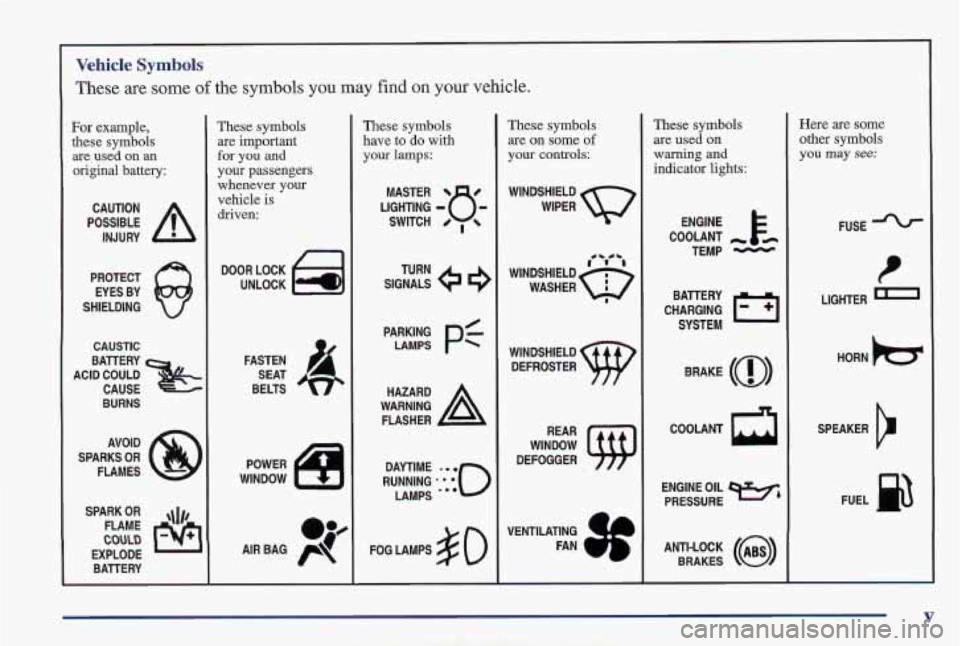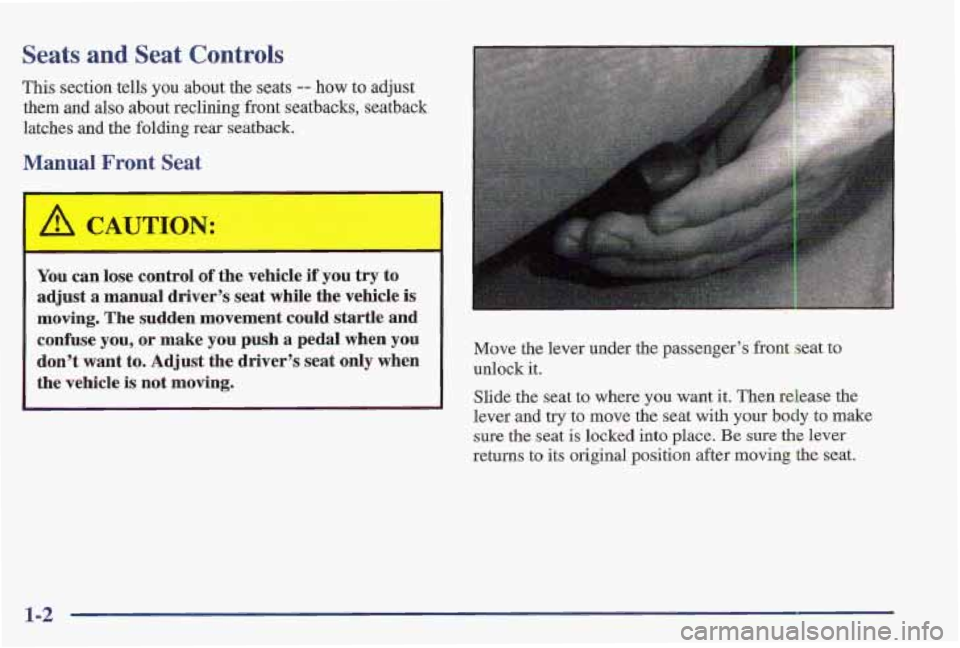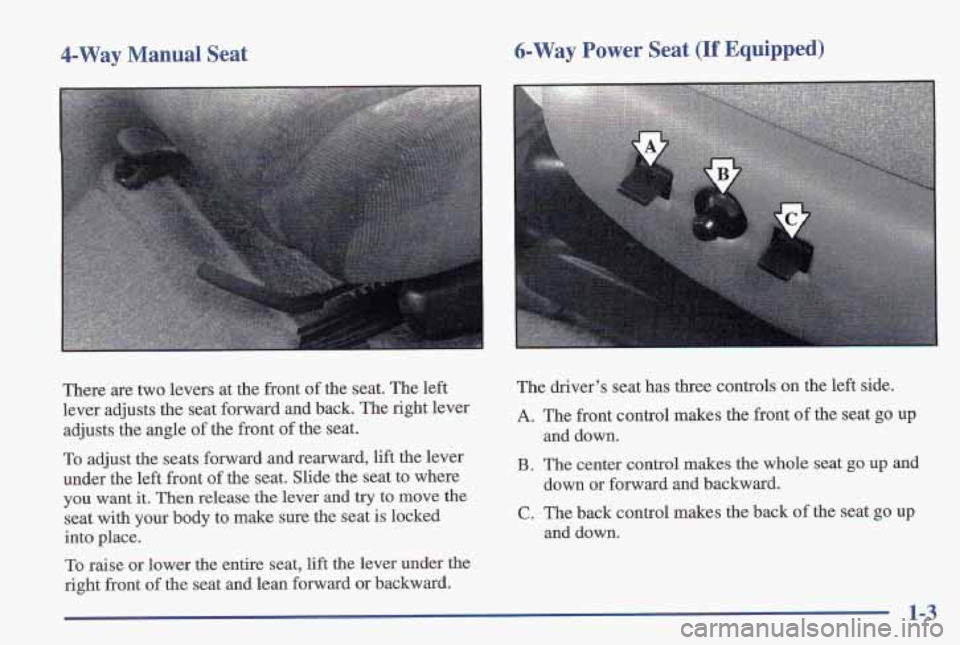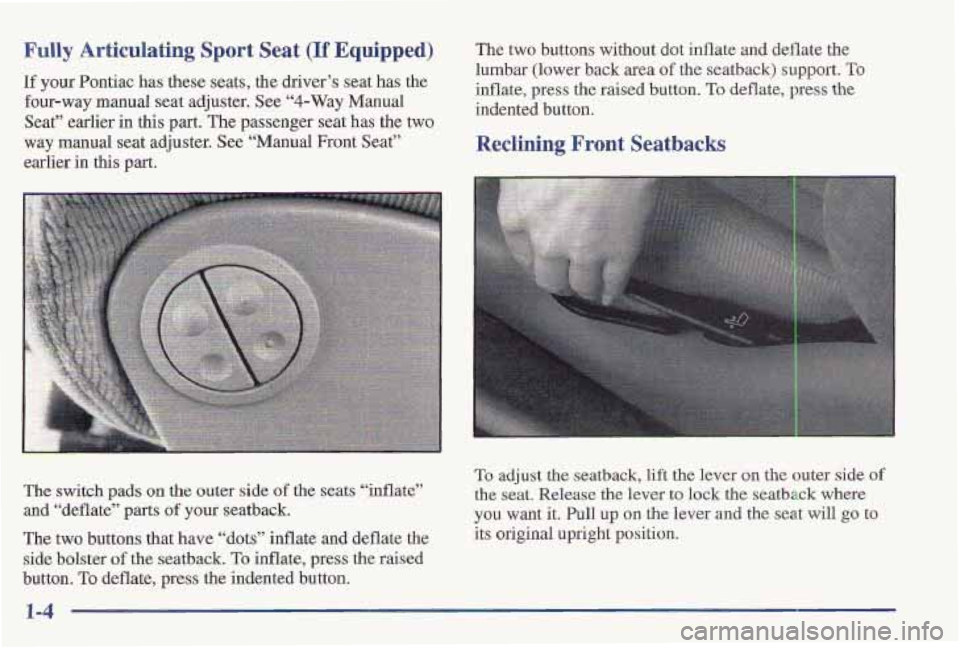lock PONTIAC FIREBIRD 1997 Owners Manual
[x] Cancel search | Manufacturer: PONTIAC, Model Year: 1997, Model line: FIREBIRD, Model: PONTIAC FIREBIRD 1997Pages: 410, PDF Size: 19.2 MB
Page 6 of 410

Vehicle Symbols
These are some of the symbols you may find on your vehicle.
For example,
these symbols
are used on an
original battery:
POSSIBLE A
CAUTION
INJURY
PROTECT EYES BY
SHIELDING
CAUSTIC
ACID COULD BATTERY
CAUSE
BURNS
AVOID
SPARKS
OR
FLAMES
FLAME
EXPLODE BATTERY
These symbols are important
for you and
your passengers
whenever your
vehicle
is
driven:
DOOR LOCK
UNLOCK
FASTEN SEAT
BELTS
.i)
AIR BAG p
These symbols
have to do with
your lamps:
SIGNALS 6
TURN
PARKING
PC LAMPS
FOG LAMPS
$0
These symbols
are on some
of
your controls:
WINDSHIELD
DEFROSTER
WINDOW
DEFOGGER
VENTILATING FAN
These symbols are used on
warning and
indicator lights:
COOLANT -
TEMP -
CHARGING BATTERY
SYSTEM
BRAKE
(0)
COOLANT a
ENGINE OIL w,
PRESSURE
ANTI-LOCK
(@)
BRAKES
Here are some
other symbols
you
may see:
FUSE
LIGHTER
1
HORN )cT
SPEAKER
b
FUEL p3
Page 9 of 410

Seats and Seat Controls
This section tells you about the seats -- how to adjust
them and also about reclining front s’eatbacks, seatback
latches and the folding rear seatback.
M-rual Front +at
You can lose control of the vehicle if you try to
adjust a manual driver’s seat while the vehicle is
moving. The sudden movement could startle and
confuse you,
or make you push a pedal when you
don’t want to. Adjust the driver’s
seat only when
the vehicle is not moving,
Move the lever under the passenger’s front seat to
unlock it,
Slide the seat to where you want it. Then release the
lever and
try to move the seat with your body to make
sure the seat is locked into place. Be sure the lever
returns
to its original position after moving the seat.
Page 10 of 410

4-Way Manual Seat 6-Way Power Seat (If Equipped)
There are two levers at the front of the seat. The left
lever adjusts the seat forward and back. The right lever
adjusts the angle of the front
of the seat.
To adjust the seats forward and rearward, lift the lever
under
the left front of the seat. Slide the seat to where
you want it. Then release the lever and try to move the
seat with your body to
make sure the seat is locked
into place.
To raise or lower the entire seat, lift the lever under the
right front
of the seat and lean forward or backward. The
driver’s seat has three controls on the left
side.
A. The front control makes the front of the seat go UP
and down.
B. The center control makes the whole seat go up and
down or forward and backward.
C. The back control makes the back of the seat go up
and down.
1-3
Page 11 of 410

Fully Articulating Sport Seat (If Equipped)
If your Pontiac has these seats, the driver’s seat has the
four-way manual seat adjuster. See
“4-Way Manual
Seat” earlier in this
part. The passenger seat has the two
way manual seat adjuster. See “Manual Front Seat”
earlier in this part. The
two buttons without dot inflate
and deflate the
lumbar (lower back area
of the seatback) support. To
inflate, press the raised button. To deflate, press the
indented button.
Reclining Front Seatbacks
I
The switch pads on the outer side of the seats “inflate”
and “deflate”
parts of your seatback.
The two buttons that have
“dots” inflate and deflate the
side bolster
of the seatback. To inflate, press the raised
button.
To deflate, press the indented button.
To adjust the seatback, lift the lever on the outer side of
the seat. Release the lever to lock the seatback where
you want it. Pull up on the lever and the’seat will go to
its original upright position.
1-4
Page 13 of 410

r
-
up, your safety belts can’t do their job when
you’re reclined like this.
The shoulder belt can’t do
its job. In a crash you
could
go into it, receiving neck or other injuries.
The lap belt can’t
do its job either. In a crash the
belt could
go up over your abdomen. The belt
forces would be there, not at your pelvic bones.
This could
cause serious internal injuries.
For proper protection when the vehicle is in
motion, have
the seatback upright. Then sit well
back in the seat and
wear your safety belt properly.
Head Restraints
Slide the head restraint up or down so that the top of the
restraint is closest to the
top of your ears. This position
reduces
the chance of a neck injury in a crash.
On some models, the head restraints tilt forward and
rearward also.
Front Seatback Latches
The front seatbacks fold
forward to let people get
into the back seat, To fold a
seatback forward, lift the
latch located on the lower
backside of the seatback.
Then
the seatback will
fold forward.
When you return the seatback to its original position,
make ,sure the seatback
is locked. The latch must be
down for the seat to work properly,
If the seatback isnlt locked, it could move
forward in a sudden stop
or crash. That could
cause injury to the person sitting there.
Always
press rearward on the seatback to be sure it
is locked.
1-6
Page 14 of 410

Folding Rear Seatback
The rear seatback in your Pontiac folds down to provide more storage space.
To fold the seatback down:
1. Pull forward on both levers.
2. Fold the seatback down.
To raise the seatback:
1. Pull it up to the locked, upright position.
2. Be sure both latches hold the seatback in place. Have
them fixed if they don’t.
Safety Belts: They’re for Everyone
This part of the manual tells you how to use safety belts
properly. It also tells you some things
you should not do
with safety belts.
And it explains the Supplemental Restraint System (SRS),
or air bag system.
Don’t let anyone ride where he or she can’t wear
a safety belt properly. If you are in a crash and
you’re not wearing a safety belt, your injuries
can be much worse.
You can hit things inside the
vehicle or be ejected from
it. You can be seriously
injured or killed.
In the same crash, you might
not be
if you are buckled up. Always fasten your
safety belt, and check that your passengers’ belts
are fastened properly too.
1-7
Page 20 of 410

How to Wear Safety Belts Properly
Adults
This part is only for people of adult size.
Be aware that there are special things to know about safety
belts and children. And there are different rules for smaller
children and babies.
If a child will be riding in your
Pontiac, see
the part of this manual called “Children.”
Follow
those rules for everyone’s protection.
First, you’ll want to know which restraint systems your
vehicle has.
We’ll start with the driver position.
Driver Position
This part describes the driver’s restraint system.
Lap-Shoulder Belt
The driver has a lap-shoulder belt. Here’s how to wear
it properly.
1. Close and lock the door.
2. Adjust the seat (to see how, see “Seats” in the Index)
so you can sit up straight.
3.
4.
Pick up the latch plate and pull the belt across you.
Don’t let it get twisted.
On convertible models, the shoulder belt may lock if
you pull the belt across you very quickly.
If this
happens, let the belt go back slightly to unlock
it.
Then pull the belt across you more slowly.
Push
the latch plate into the buckle until it clicks.
1-13
Page 22 of 410

The lap part of the belt should be worn low and snug on
the hips, just touching the thighs. In a crash, this applies
force
to the strong pelvic bones. And you’d be less
likely
to slide under the lap belt. If you slid under it, the
belt would apply force at your abdomen. This could
cause serious or even fatal injuries. The shoulder
belt
should go over the shoulder and across the chest.
These parts of the body are best able to take belt
restraining forces.
The safety belt locks if there’s a
sudden stop or crash.
On convertible models, the safety belt also locks if you
pull the belt very quickly out
of the retractor.
1-15
Page 34 of 410

Rear Seat Passengers
It’s very important for rear seat passengers to buckle up!
Accident statistics show that unbelted people in the rear
seat are hurt more often in crashes than those who are
wearing safety belts.
Rear passengers who aren’t safety belted can be thrown
out
of the vehicle in a crash. And they can strike others
in the vehicle who
are wearing safety belts.
n
Lap-Shoulder Belt
The rear seats have lap-shoulder belts. Here’s how to
wear one properly.
1. Pick up the latch plate and pull the belt across you.
Don’t let it get twisted.
On convertible models, the shoulder belt may lock if
you pull the belt across you very quickly.
If this
happens, let the belt
go back slightly to unlock it.
Then pull the belt across you more slowly.
2. Push the latch plate into the buckle until it clicks.
1-27
Page 36 of 410

The lap part of the belt should be worn low and snug on
the hips, just touching the thighs. In a crash, this applies
force to the strong pelvic bones. And you’d be less likely
to slide under the lap belt.
If you slid under it, the
belt would apply force at your abdomen.
This could
cause serious
or even fatal injuries. The shoulder belt
should
go over the shoulder and across the chest.
These parts of the body are best able to take belt
restraining forces.
The safety belt locks if there’s a sudden stop
or a crash.
On convertible models, the safety belt also locks if you
pull the belt very quickly out
of the retractor.
A CAUTION:
I
I
You can be seriously hurt if your shoulder belt is
too loose. In a crash, you would move forward
too much, which could increase injury. The
shoulder belt should
fit against your body.
1-29